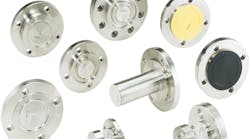When forming airtight connections between metal surfaces, any imperfections will allow a leak path and result in a poor seal. Different methods are available for creating leak-tight seals between hard mating surfaces. Most of these methods compress a softer material between two harder surfaces. The softer material is compressed to fill gaps, scratches, machining marks and other imperfections in the hard surfaces to form a fluid-tight seal. Liquid thread sealant or a thin layer of Teflon is typically used on tapered threads. Gaskets are used for flat, hard mating surfaces and can be made of cork, paper, metal, rubber and many other materials. Gaskets are compressed with bolts or straight threads. Elastomeric seals can be manufactured as flat gaskets or contoured shapes. Despite their shape, they perform a function by using an interference fit.
An O-ring is a special type of elastomeric seal that is round with a round cross-section. This shape allows O-rings to be used in a multitude of situations. It also makes them fairly simple to manufacture. O-rings are used in a variety of mechanical piping connections. They form seals by fitting tightly around pipes, after which they are compressed by springs, threads or external mechanical means.
Whereas liquid sealants and paper gaskets can only be compressed once, elastomeric seals return to their original shape. This is important for temporary connections or connections designed to be disassembled, but they can also be used in permanent connections. Elastomers are polymers with specific elastic qualities.
Plastics versus polymers
Before discussing the special case of elastomers or the variety of polymeric compounds that are commonly used, a short vocabulary lesson is in order. The words “plastic” and “polymer” are often used interchangeably, but plastic refers to all moldable synthetic or semisynthetic organic solids. Polymer comes from ancient Greek words meaning “many” and “parts.” A polymer is a large molecule composed of many repeated monomers or chains of monomers. The monomer gives the polymer its name and chemical properties, while the connections between monomers, including cross-links, dictate the physical properties. Some well-known natural polymers are wool, rubber, silk, DNA and cellulose. Most plastics are synthetic polymers, so even though a difference exists, plastic products are created from a synthetic polymer, and the terms are interchangeable.
An elastomer is a polymer that goes through an additional cross-linking process to link the chains side-to-side in addition to the end-to-end connections of the polymer. Cross-linking can improve the elasticity of polymers by allowing the chains to bend and change shape without breaking. Different additives can be used in addition to specific methods of cross-linking that are all intended to yield more desirable physical properties. Some additives improve high temperature resistance, while others can improve chemical resistance or elasticity. Additives and cross-linking processes can be combined to tailor polymers to the specific needs of an application.
Types of elastomers
Different types of elastomers are manufactured to different standards. The ASTM D2000 Standard Classification System for Rubber Products in Automotive Applications defines type based on heat resistance and class based on oil resistance. These classifications are designed to help engineers with selection for different applications. In addition to type and class, elastomers are also chosen based on their physical properties.
Elasticity is a major factor when designing elastomers, and a seal’s performance in this specific area can be found by measuring compression set. When elastomers are compressed, they, for the most part, return to their original shape. Compression set is the proportion of deformation that does not return when the compressive force is removed and is an overall indicator of how elastic an elastomer is. Tests are conducted according to performance standards such as ASTM D395. In general, a compression set test starts taking a precise measurement of an elastomer. The elastomer is then restrained and compressed with either a certain force or a certain percentage of volume change. When the force is removed, the elastomer is measured again. The percent of plastic deformation that remains after force is removed is the compression set of the elastomer.
Chemical factors
In addition to physical properties, chemical compatibility must be considered when selecting seals for particular applications. One of the most fundamental chemical compatibility concerns is whether the media sealed inside the system will damage the sealing element. As is taught in most introductory chemistry classes, “Like dissolves like.” In this respect, “like” refers to whether the molecules are polar or nonpolar. Polar molecules have positively charged ends and negatively charged ends, or poles. These poles affect the structure of whatever the molecules make up as well as that material’s interaction with other substances. Nonpolar molecules are arranged so they have two positive, two negative or no distinct poles. Polar molecules have an unbalanced distribution of electron bonding groups, causing an uneven charge. When combined, they will try to bond with other polar molecules. Nonpolar molecules have an even distribution of electron bonding groups, thus the electronegativity is balanced. As a result, nonpolar molecules will hover around each other, exchanging electrons. In general, nonpolar molecules are more stable in the presence of polar molecules since attraction can be fended off because of difference in atomic bonds. Seals made up of polar atoms should be used with nonpolar fluids and vice versa.
Environmental factors
Many environmental factors can negatively affect elastomers. Regardless of the source, elastomeric seals can degrade in two ways. If the cross-linking bonds are attacked, the material loses its elasticity and becomes brittle. If the polymer bonds are attacked, the seal loses its basic structure. Temperature can affect the efficacy of an elastomeric seal. High temperatures can attack the cross-linking bonds, causing permanent damage to the molecular structure. Low temperatures can affect the elasticity of the seal, making it rigid and brittle. This is usually a temporary effect unless physical stress causes damage to the unusually brittle seal.
Installation factors
Installation requires its own considerations. If lubricants are used, the lubricant needs to be compatible with the elastomer, the material of the system and the contents of the system. Just as excessive compression can negatively influence the performance of elastomers, too much tension, which is a technical way to say stretching, can have similar negative effects on elastomeric seals. Depending on the design of seals, any unintended twisting during installation can cause localized compressive and tensile stresses. Elastomers need to be installed against smooth, clean surfaces with blunt tools. Dirt, debris, sharp tools and sharp mating parts can potentially damage seals before they have a chance to perform their intended function of filling imperfections to create fluid-tight seals.
Importance of selecting the right elastomer
O-rings are specialized elastomeric seals, which are specialized polymers. Elastomeric seals are selected not just for their elastic qualities, but also for their inherent and engineered resistance to chemicals and harsh environments. Polymers and their specialized cousins, elastomers, are used in a growing number of applications across multiple industries. Every step of their production and installation adds another layer of complexity, but also imparts desirable traits for specialized applications.
Small changes to the chemical formulation of an elastomer impart physical characteristics and resistances that can be tailored to meet specific requirements. Various methods of curing and cross-linking also produce a variety of characteristics. Finding an optimal mix between physical and chemical properties while balancing economic factors and availability complicates the decision process. While decisions are largely based on manufacturing and performance standards, it is the responsibility of each engineer to choose from the available products that best fit each application.
Evan Cusick is a product engineer for metals at Viega LLC. He is responsible for all technical aspects of Viega’s metal product lines, including the Viega ProPress system for copper and Viega ProPress system for stainless steel as well as the Viega MegaPress and MegaPressG systems. Cusick joined Viega in 2012. For more information, visit viega.us.



